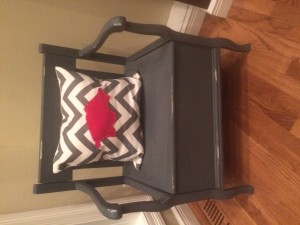I’m a DIY dummy. But while I can’t do it myself, I love finding treasures that others have repurposed/upcycled/refurbished and made beautiful again. There’s something about the character, tradition and memories associated with something old and established that draws me to it, more than the sometimes sterile and dull feel of things that are new or modern. I love being in people’s homes where you can see the mark and character of the family who lives there – photos, furniture, books, toys on the floor – whatever. I don’t like homes that have no personal touches – that don’t tell some story of the people who call it home.
In the last few years I’ve put some older furniture pieces with our newer ones, and I love seeing the mix. In our dining room is my great-grandparents’ table and chairs, which by the time they found me were painted avocado green with orange velvet seats. They’re now restored to a beautiful dark wood, and I love knowing we’re sharing meals and memories around the same table where three generations before me did the same. We’ve also got E’s grandparents’ odd square table in a corner, filled with photos, and a flea market high-back bench in the hallway, hiding the kids’ kicked-off shoes underneath.
I get excited for friends who buy older homes to fix up and make more functional, because there’s just something beautiful about taking what’s already here and making it new, rather than starting from scratch. As my friend Ivy, who makes beautiful “upcycled” jewelry pieces through her company Tarnished Charm, says: “Repurposing is about making a conscious and deliberate choice to find beauty and purpose in old, forgotten things and give them a new life.”
Restoration. Renewal. Beauty and purpose. Beautiful words, for things and for people.
I shared a Facebook post many months ago on the parallels between a life of faith and the Japanese art of Kintsugi, a method of repairing cracked and broken pottery by putting it back together and painting the cracked lines gold. The philosophy is to treat breakage and repair as part of the history of an object, rather than something to disguise. I won’t pound you over the head with the metaphor, but it’s a beautiful philosophy. Embracing flaws and the repairs, rather than tossing out the pieces…. Because just as pottery bears the scars and stains of wear and tear and use, so do we as people. And it can be really beautiful when we embrace each other’s flaws, and encourage and help those who, through faith, overcome their brokenness and are restored.
I had no idea what to do recently with a toy bench that my mom and grandmother had both used as young girls. It was intricately painted with toys and scenes and bright colors, and had their names and birth dates on it. But it was old and broken and pretty useless in its current form, and we were way past the stage of needing toy storage. So, I called my friend Gwen, who makes magic out of old furniture, and told her she could have the bench to paint and re-sell. I didn’t think we had any use for it.
Luckily, Gwen knew better. After telling her the long history of the toy bench and leaving it with her, I forgot about it. So when Gwen showed up with that bench restored and repainted, with a cute Razorback pillow that was perfect for our Arkansas-football-cheering family, I put it in a place of honor and it looks adorable. And she did it as a gift. Under the bench seat, I taped a paper detailing the history of the bench, and a photo of the old version. The bench has a story, and I’ve preserved that, but by repairing and restoring its broken parts, it has a future, too. And I like that.



what a wonderful story ..unfortunately many of the things I had were stored in my basement and were destroyed by hurricane sandy…I loved hearing this story and I an so happy that your friend was able to restore it for you
Bonnie, how sad! Even though people remind us they are “just things” – there are memories and emotions attached to some heirlooms…. It hurts to lose them.
Love this…so true!
Thanks Jill!